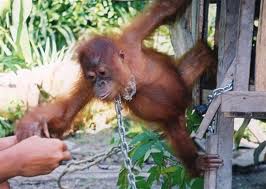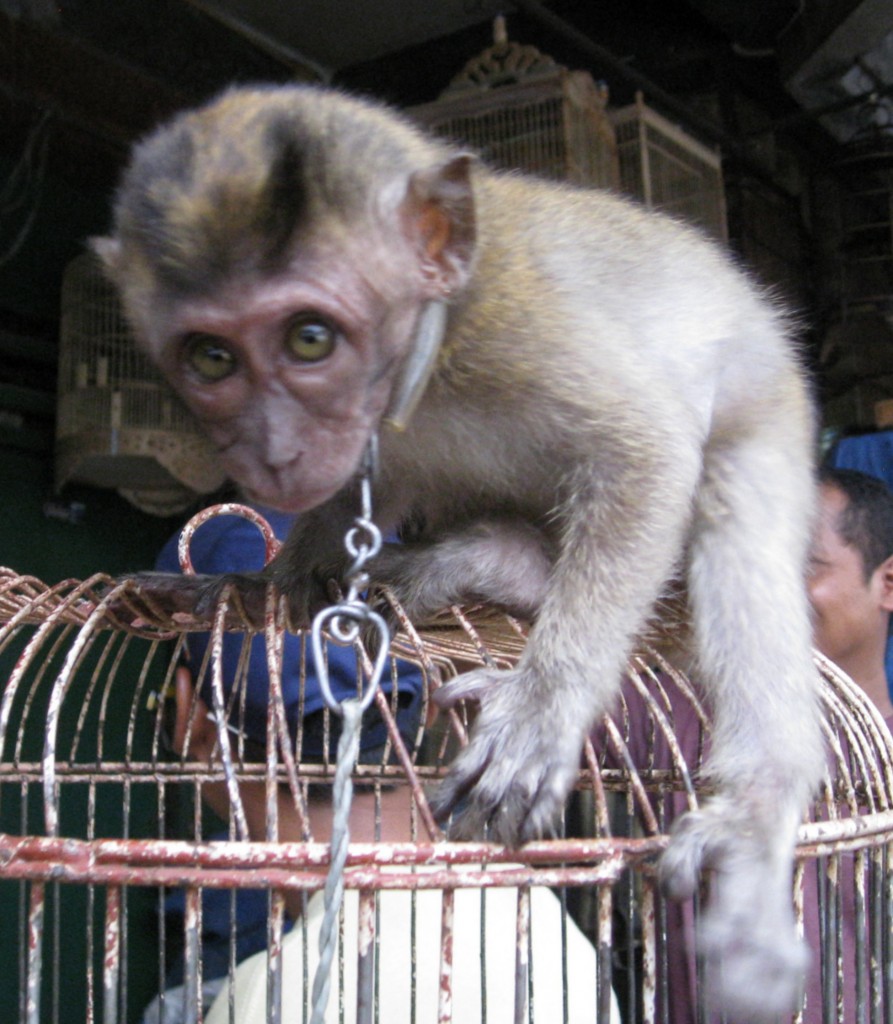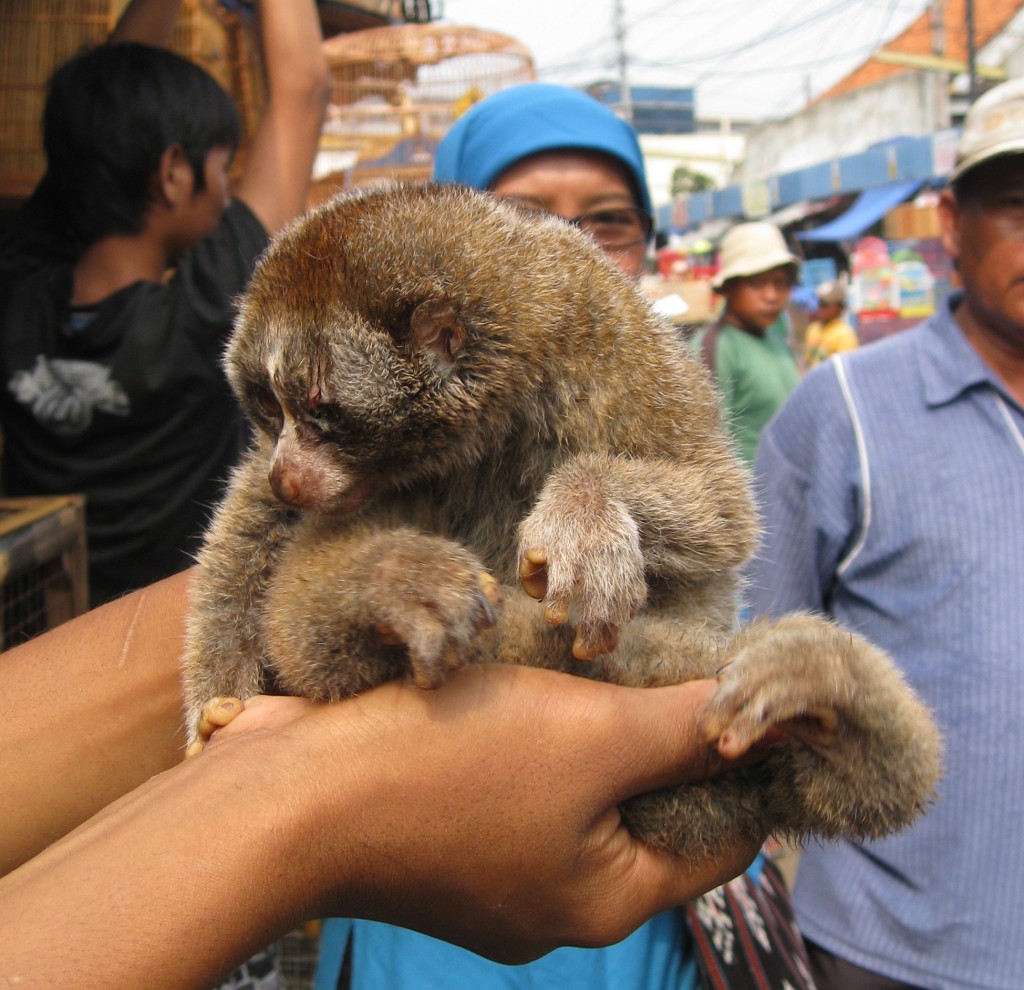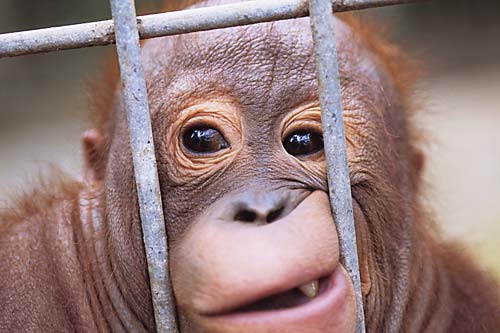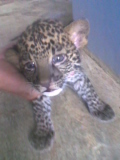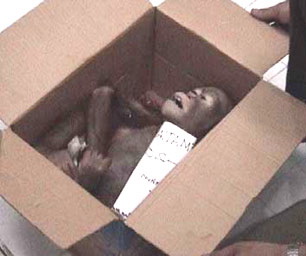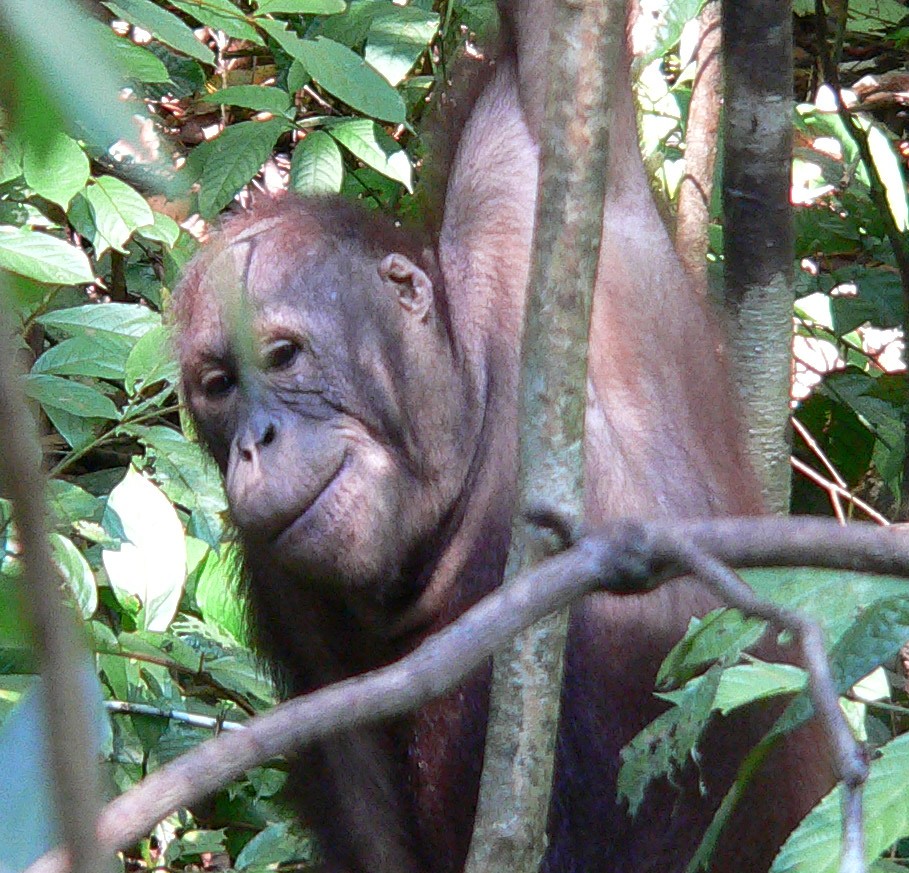This post now on Google News
and on the syndicated BasilandSpice.com
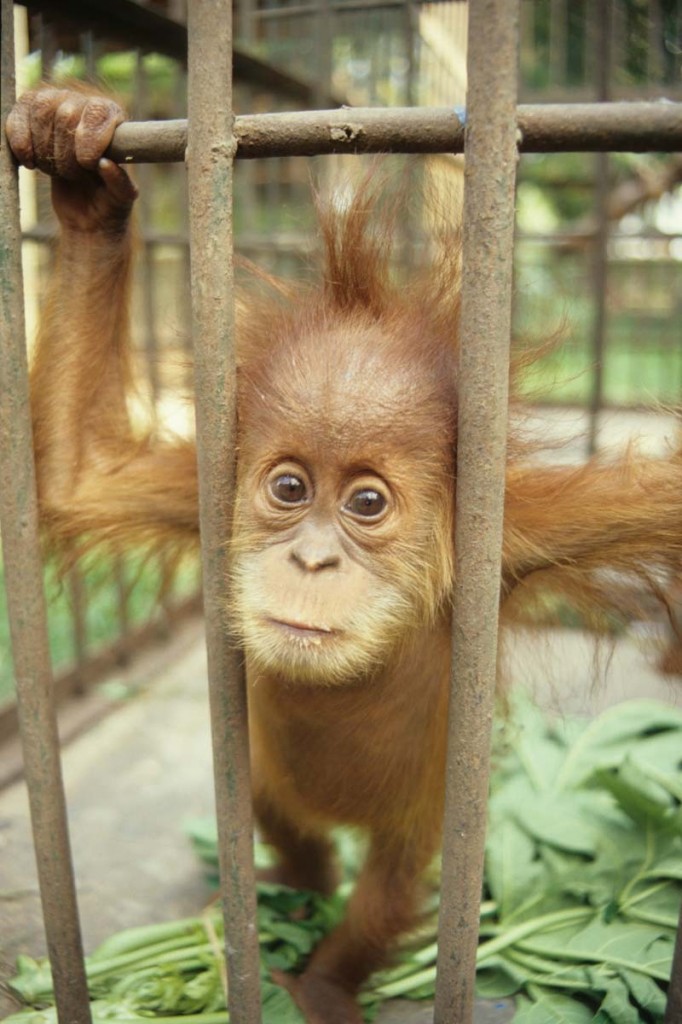
A baby orangutan living as a pet. Photo by Chris Shepherd (TRAFFIC Southeast Asia); used with permission. Originally printed in TRAFFIC publication "In Full Swing..." listed below.
Pet trade threatens orangutan survival
“Having a pet orangutan is a status symbol,” I was told by my Indonesian friend Ria, who lives and works in Jakarta, Indonesia’s capital. Doesn’t matter if the animal lives in a small, dirty cage behind the house, which most do; it’s still a social asset to have one.
That’s too bad, because the local, national, and international demand for young orangutans as pets is a major threat to the survival of both species: the Bornean orangutan and Sumatran orangutan. Since both are endangered, they are theoretically protected by law from commercial trade. However, in Indonesia, these laws are mostly ignored.
Habitat loss remains the single biggest threat to orangutans, but as it turns out, the pet trade and deforestation are closely linked.
At the market, I was offered an orangutan and a leopard
Almost every Indonesian city has a bird or wildlife market, where legal and illegal species are sold by independent vendors to anyone who can pay. I went to 4 of these markets during my Asian travels, including Indonesia’s biggest market – Pramuka, in downtown Jakarta. I hired an Indonesian from “ProFauna Indonesia” (a wildlife conservation NGO in Jakarta) to go with me as my guide and translator.
We saw plenty of wild-caught primates, birds, reptiles, and small mammals at Pramuka. But we didn’t see any orangutans. We were, however, offered a baby orangutan for the price of 20-25 million IDR ($2200-2800) and an adult orangutan for 30 million IDR ($3300). Pramuka is famous for its network of homes behind the market (referred to as “in the back”) where especially valuable or illegal animals are kept safely out of sight until a sale is made.
Vendors often keep photos of their illegal (endangered and thus protected) animals on their cell phones, to show interested buyers. For example, we were shown a photo of an available baby leopard that the vendor said was “in the back.” The leopard was offered to us for 80 million IDRs ($8800), although the vendor called it a “Javan tiger” to justify the price. [Javan tigers are actually extinct, although many potential buyers may not know that.]
For forest-dwellers, orangutans are valuable trade commodities
Although orangutan sales in the past may have been concentrated at wildlife markets, nowadays sales often occur at other locations. Pet orangutans may be moved from the interior of the country to more developed coastal towns, or professional traders may travel to a remote area and buy or order young orangutans to transport to populated areas. According to TRAFFIC’s Vincent Nijman, most forest-dwelling people in Indonesia know the commercial value of an infant orangutan. Given the absence of effective law enforcement, few will resist the opportunity to obtain an infant to sell In a country where more than half the population survives on $2/day or less, young orangutans are regarded as valuable trade commodities.
Unchecked timber industry yields orangutans for market
The hunting and capturing of orangutans for the pet trade is, in a way, a by-product of the timber trade and the conversion of forests to palm-oil plantations. As roads are created to provide access to not-yet plundered forests, these arboreal red apes become more accessible to humans with guns. Newly exposed mothers are often shot to obtain their infants. As trees are felled, orangutans may be killed or they may become stranded and vulnerable to capture.
Up to 15 orangutans die to get one live infant to market
TRAFFIC published a number of estimates of the “loss rate” – the number of orangutans killed in order to get one live orang to a village or city where it can be sold. Quite often both mother and infant are killed if the mother is shot from a tree and falls, so another mother is shot to try again. That’s a loss rate of 3. And in shipping the infants, 5 may be packed in one crate in hopes that one animal will arrive alive. If 4 die, that pushes the loss rate to 7. Some researchers estimate average loss rates as high as 15! (See the 2009 paper listed below for more about loss rate assessments.)
The situation is frustrating, and even incomprehensible in some ways. What is the Indonesian government doing to stop this “harvesting” of orangutans like they were ears of corn?
Indonesia a trade center due to lax enforcement of wildlife laws
Here’s a fact that surprises most Americans: the illegal trade in animals and animal parts is the 3rd biggest blackmarket in the world, behind drugs and arms (according to Interpol).
Indonesia is an epicenter of this illegal trade, because of the country’s rich tropical biodiversity and because of the laissez-faire attitude of the Indonesian government. Although the country has enacted a range of laws and regulations to protect species and limit deforestation, the government fails to enforce these laws effectively. Indonesia is also a Party to the Convention on International Trade in Endangered Species (CITES), and all orangutans are listed in Appendix I, which prohibits all international commercial trade of these species among contracting Parties. Yet this treaty, like the local legislation, is generally ignored. I was told by several Indonesian conservation workers that if an Indonesian is found to possess a pet orangutan, the chances of having the animal confiscated or of facing prosecution are extremely low. Rather, the pet owner can, upon discovery of his pet, probably obtain a permit from the government that will allow him to legally keep the orangutan.
TRAFFIC researcher Vincent Nijman found that, in spite of existing laws and treaties, the number of confiscated orangutans being delivered to rescue centers and the number of new arrivals at local zoos has remained more or less steady over the last 15 years, suggesting that the brisk trade in orangutans is not decreasing.
What should be done?
“TRAFFIC: the wildlife trade monitoring network” is very active in Southeast Asia and has studied the situation closely and made several recommendations that seem to hit the nail on the head. Their published papers are excellent sources of information. (See “Sources” below.) When I got home from my journey, I sent TRAFFIC copies of all my wildlife-market photos and videos, in case they might be helpful. They’re working hard; I want to help!
TRAFFIC’s recommendations for reducing the trade in orangutans are as follows (I’ve condensed and abbreviated):
1. Better protection of the remaining forest is needed – through the Indonesian government, land concession holders (timber and palm-oil companies), and landowners.
2.Wildlife protection laws need to be enforced more effectively.
3. Handing out registration letters to make pets “legal” needs to be stopped immediately. Persons whose protected wildlife is confiscated should face legal charges as a deterrent to others.
4. The relationship between poaching of orangutans and illegal logging should be more thoroughly assessed.
5. The major ports of Indonesia should be monitored more stringently to curb international sales of orangutans.
6. Co-operation between the government and NGOs that work to protect orangutans and rehabilitate confiscated orphans should be increased.
7. Bold and innovative approaches are needed to educate the public with regard to buying, selling, and keeping protected wildlife as pets.
(See the 2005b paper listed below for more about these recommendations.)
Coming up
In my next posts about s.e. Asia, I’ll explore the causes of deforestation on Borneo and Sumatra, and why it continues unabated in spite of the considerable efforts of NGOs to stop or slow it. I’ll also post the pictures we took of wild-caught and protected birds in the bird markets of Jakarta and Singapore. Why are wild birds so popular as pets in tropical Asia? I’ll tell you what we learned.
My previous posts on orangutans in s.e. Asia:
Orangutans dwindle as Borneo, Sumatra converted to palm-oil plantations August 3, 2010
My search for a wild orangutan in Borneo and Sumatra August 16, 2010
Published sources for this post and for additional information:
Vincent Nijman. 2005a. Hanging in the Balance: An Assessment of Trade in Orang-utans and Gibbons
on Kalimantan, Indonesia. A TRAFFIC Southeast Asia report.
Vincent Nijman. 2009. An Assessment of Trade in Gibbons and Orang-utans in Sumatra, Indonesia. A TRAFFIC Southeast Asia report.
Vincent Nijman. June 2005b. In Full Swing: An Assessment of Trade in Orangutans and Gibbons on Java and Bali. A TRAFFIC Southeast Asia report.
Serge A. Wich et al. 2008. Distribution and conservation status of the orang-utan (Pongo spp.) on Borneo and Sumatra: how many remain? Fauna and Flora International. Oryx 42(3):329-339.
Eric Meijaard et al. August 11, 2010. Hunting a key factor in Orangutan’s decline. TRAFFIC home page.
Web sites for more information:
Traffic: the wildlife trade monitoring network
Key words: orangutan, orangutans, Southeast Asia, primates, great apes, endangered, threatened, habitat loss, pet trade, TRAFFIC, wildlife markets, Pramuka, deforestation, timber industry, palm oil plantations
